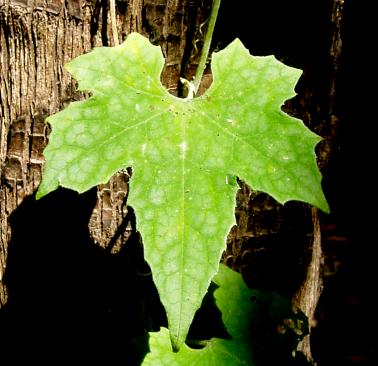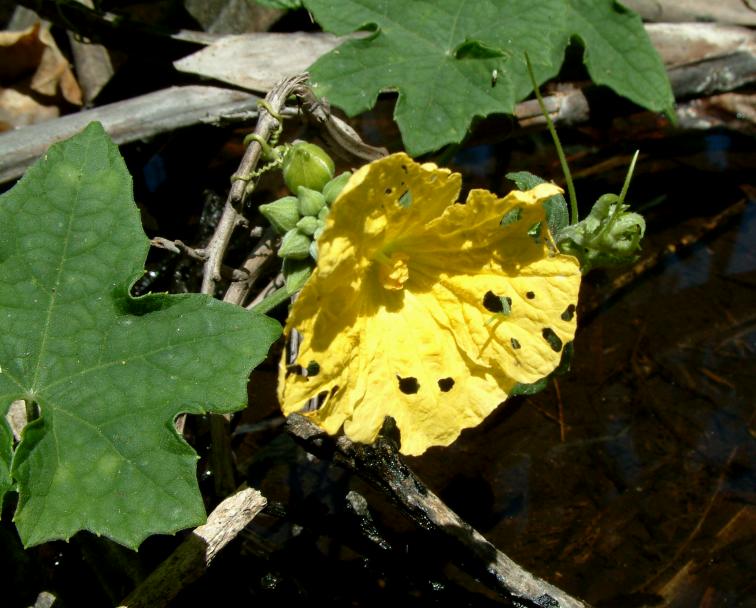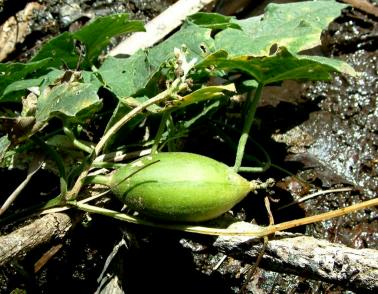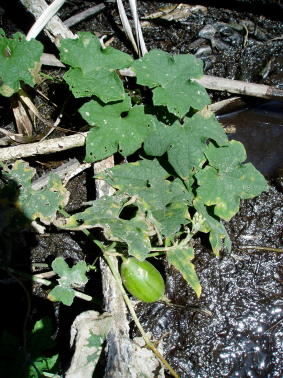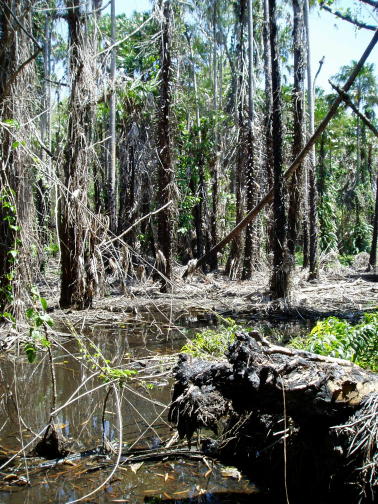Plant
photos
a change of format
TENPS Annual General Meeting
October 21st
Luffa cylindrica Mill.
Last updated 2 October 2004 |
|
Luffa cyclindrica is an annual climbing herb which flowers fruits then dies. Members of this genusare found throughout tropical regions of Africa, America, Asia and Australia. In the NT two species have been recorded, L. cyclindrica and L. graveolens. They are mostly found in monsoon forest, vine thickets, amongst Pandanus and paperbark swamps for example along the Daly and Howard rivers. Strangely they have been reported at Montera waterhole in the north east Simpson desert. It is not known whether this plant has any nutritional value.
|
|
|
|
The green leaves are palmate with 3 to 7 lobes measuring 4 to 18 cm long and 3 to 20 cm wide. This photo shows details of the characteristic leaf from a vine climbing the trunk of Livistonia benthami. These vines were seen to climb several metres up the trunk of the supporting palms. The vines were also seen to grow prostrate along fallen trunks and fronds. |
Details of the yellow L. cyclindrica flower. Insect grazing was evident on most of the flowers seen. There are both male and female flowers. |
|
|
|
|
The green ellipsoidal fruit usually some 5 to 215 cm long and 2 to 7 cm in diameter still attached to a vine. |
|
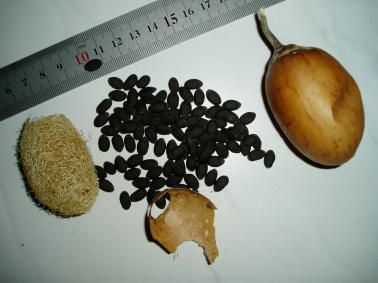 |
|
| Details of the dried intact fruit, seed from the two fruit pictures and the fibrous "loofah" inside. The brittle skin easily peels away to reveal the fibrous endocarp inside. The flat black seeds in this photo were taken from just one of the fruits. |
Livistonia benthami and paperbarks ravaged by fire last season
attempting to re-establish a jungle. L. cylindrica was on the of
the vine species found growing in this area.
These photo were taken during TENPS field trip to a jungle nicknamed Pig Dog Max jungle near the Howard River. The jungle was christened thus after spotting a grave marker with Max's name on it in close proximity. |
Source: Cowie, ID, Short PD, Osterkamp Madsen M. Floodplain Flora: a flora of the coastal floodplains of the Northern Territory Australia. Parks and Wildlife Commission of the Northern Northern 2000 ISBN 0 642 56808
Other Luffa cylindrica information
Sponge luffa is a tropical running vine with rounded leaves and yellow flowers. The fruits are smooth and cylindrical shaped. The length of the fruit is one to two feet. The young fruit is used as a cooked vegetable although some gardeners grow Smooth luffa for the fibrous interior. The fibrous netting is an excellent sponge but there are also industrial applications (such as a waterfilter). In Suriname's traditional medicine a tea of the leaves is used as a diuretic, while juice of the fruit is used against internal hemorrhage. The seeds have laxative properties. http://www.tropilab.com/luf-cyl.html
Traditionally, angled luffa was used for vegetable production and sponge luffa for sponge production, as the latter was more fibrous . Two distinct hybrid groups of sponge luffa exist: one for eating and one for sponge production. http://www.ahs.cqu.edu.au/info/science/psg/AsianVeg/Luffa.html
Listed as weed by The Global Compendium of Weeds. http://www.hear.org/gcw/html/autogend/species/11837.HTM
From the cucumber and marrow family, the Luffa is a rather curious example which originates from America. After drying, the fibrous internal structure of the Luffa magically transforms itself into a' sponge', 30cm long. Home-grown sponges, whatever next?! Treated as a half hardy annual in all areas, Luffa can be grown on any ordinary soil in a position of full sun.
Sow February to May. Soak seed in warm water for 2 hours before sowing. Germinate singly in pots, at 20 to 30C on the surface of a good free draining, damp seed compost. Apply a sprinkling of compost or vermiculite, 6mm thick. Place in a propagator or seal container inside a polythene bag until after germination which usually takes 7 to 21 days. Do not exclude light at any stage as this is beneficial to germination.
Plant out after all risk of frost, 30cm apart in a moist, well drained soil in full sun.
Provide support to allow plants to trail or climb, and give a humid atmosphere. Pollinate the female flowers (which have a green fruit behind them) by brushing the male flowers (which have no fruit) against them. Treat as a Half Hardy Annua. http://seeds.thompson-morgan.com/uk/en/product/ex6925/1?SA=1303
Return to Home page

